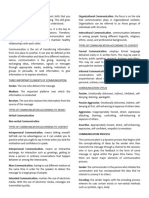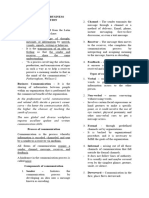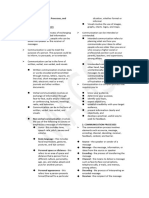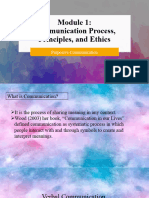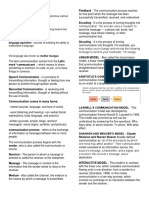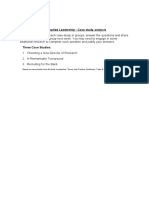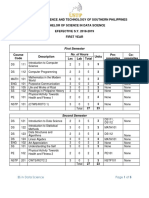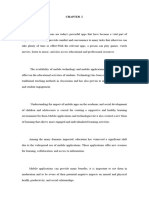0 ratings0% found this document useful (0 votes)
10 viewsPerdev Reviewer
Perdev Reviewer
Uploaded by
cherryl cruzCommunication is the exchange of information between two or more parties. It is effective when the message is understood and stimulates thought or action. There are various forms of communication including interpersonal communication between two people, small group communication, public communication, and mass communication from one source to many receivers. Communication occurs across different contexts such as physical, cultural, social, and temporal environments and can involve verbal, oral, written, or nonverbal exchange through different channels and media.
Copyright:
© All Rights Reserved
Available Formats
Download as DOCX, PDF, TXT or read online from Scribd
Perdev Reviewer
Perdev Reviewer
Uploaded by
cherryl cruz0 ratings0% found this document useful (0 votes)
10 views2 pagesCommunication is the exchange of information between two or more parties. It is effective when the message is understood and stimulates thought or action. There are various forms of communication including interpersonal communication between two people, small group communication, public communication, and mass communication from one source to many receivers. Communication occurs across different contexts such as physical, cultural, social, and temporal environments and can involve verbal, oral, written, or nonverbal exchange through different channels and media.
Original Title
PERDEV REVIEWER
Copyright
© © All Rights Reserved
Available Formats
DOCX, PDF, TXT or read online from Scribd
Share this document
Did you find this document useful?
Is this content inappropriate?
Communication is the exchange of information between two or more parties. It is effective when the message is understood and stimulates thought or action. There are various forms of communication including interpersonal communication between two people, small group communication, public communication, and mass communication from one source to many receivers. Communication occurs across different contexts such as physical, cultural, social, and temporal environments and can involve verbal, oral, written, or nonverbal exchange through different channels and media.
Copyright:
© All Rights Reserved
Available Formats
Download as DOCX, PDF, TXT or read online from Scribd
Download as docx, pdf, or txt
0 ratings0% found this document useful (0 votes)
10 views2 pagesPerdev Reviewer
Perdev Reviewer
Uploaded by
cherryl cruzCommunication is the exchange of information between two or more parties. It is effective when the message is understood and stimulates thought or action. There are various forms of communication including interpersonal communication between two people, small group communication, public communication, and mass communication from one source to many receivers. Communication occurs across different contexts such as physical, cultural, social, and temporal environments and can involve verbal, oral, written, or nonverbal exchange through different channels and media.
Copyright:
© All Rights Reserved
Available Formats
Download as DOCX, PDF, TXT or read online from Scribd
Download as docx, pdf, or txt
You are on page 1of 2
Communication - process of exchanging Forms of Comm.
information, ideas, thoughts, feelings and
Intrapersonal Comm - yourself-
emotions through speech, signals, writings, and
when you talk with, learn about, and
behavior.
judge yourself
Communication is effective only when the Interpersonal Comm - occurs when you
message is understood and when it interact with a person with
stimulates action or encourages the receiver to whom you have some kind of
think in new ways. relationship;
Small-group comm - occurs when you
Characteristics of Comm.
interact with a person with
Two or more persons whom you have some kind of
Exchange of ideas relationship.
Mutual understanding Public Comm - communication
Direct and indirect communication between a speaker and an audience.
Continuous process Computer mediated comm - includes all
Use of words as well as symbols forms of communication between
people with the use of computer or
Skills of Human Comm. smartphones or internet.
Self- presentation skills - enable you to Mass Comm - refers to communication
present yourself as confident, from one source to
likable, approachable, and credible many receivers who may be scattered
person. throughout the world.
Relationship skills - help you build Comm Context
friendships, enter into love
relationships, work with colleagues, and Physical - tangible or concrete
interact environment.
with family members. Cultural - lifestyles, beliefs,
Interviewing skills - enable you to values, behavior, and communication of
interact to gain information, to a group.
successfully present yourself to get Socio-psychological - has to do
the job with the status relationships among
Group interaction and leadership - helps speakers,
you participate effectively in the formality of the situation, or the
relationship and task groups- norms of a group or organization.
informative, problem- Temporal - message’s position
solving, and brain-storming groups, at within a sequence of events
home or at
Types of Comm
work- as a member and as a leader.
Presentation or Public speaking - Verbal - the form of communication in
enables you to manage your fear and which message is transmitted verbally.
make it Oral - Spoken words are used.
work for you, rather than against you. It includes face-to-face conversations,
speech, telephonic conversation, video,
radio, television, voice-over The Organizational – hierarchy and power
Internet. In oral communication, Public/Rhetorical - Communication
communication influence by pitch, apprehension; delivery effectiveness;
volume, speed and clarity of speaking. speech and text criticism; ethical
Written - written signs or symbols are speechmaking; popular culture analysis
used to communicate. Mass/Media - Use of media;
Non-verbal - sending or receiving affiliation and television programming;
of wordless messages like gestures, television and values; media and need
body language, posture facial fulfillment; effects of social networking
expression. sites
Cultural - Culture and rule-setting;
Principles of comm
culture and anxiety; hegemony;
Communication is purposeful ethnocentrism
Communication involves choices
Communication apprehension- a generalized
Communication is Ambiguous fear or anxiety regarding communicating in
Communication involves content and front of others.
relationship dimensions
Communication has a power dimension
Mass media-channels or delivery modes for
Communication is punctuated
mass messages.
Communication inevitable, irreversible,
and unrepeatable
Mass Communication- communication to a
7 contexts in comm field: large audience via various channels (e.g., radio,
Contexts - environments in which Internet, television, etc.)
communication takes place
New media- computer-related technology
Situational contexts - environments that are
limited by such factors as the number of Culture- a community of meanings with, among
people present, the feedback, the space other things, a shared body of knowledge.
between communicators, among others.
7 Contexts: Cultural communication- communication
between and among individuals whose cultural
Intrapersonal - Impression formation backgrounds vary.
and decision making; symbols and
meaning; observations and attributions;
Co-cultures- groups of individuals who are part
ego involvement and persuasion
of the same larger culture, but who can be
Interpersonal - Relationship classified around various identities
maintenance strategies; relational
intimacy; relationship
control; interpersonal attraction
Small group - Gender and group
leadership; group vulnerability; groups
and stories; group decision making; task
difficulty
You might also like
- Silabus Kursus Bahasa Inggris PDF FreeDocument5 pagesSilabus Kursus Bahasa Inggris PDF Freerahmat tile100% (3)
- Functional Analysis Screening ToolDocument1 pageFunctional Analysis Screening ToolOlivia Woodland100% (1)
- Purposive CommunicationDocument10 pagesPurposive CommunicationmdotcdotNo ratings yet
- Sq-Diass ReviewerDocument4 pagesSq-Diass ReviewerCharisse Deirdre TulioNo ratings yet
- Hand OutDocument6 pagesHand OutGevelyn BautistaNo ratings yet
- Purposive Communication Module NotesDocument8 pagesPurposive Communication Module NotesnightowlreaderNo ratings yet
- Midterms Purpcom ReviewerDocument4 pagesMidterms Purpcom ReviewerfeysbukuserNo ratings yet
- Process of CommunicationDocument46 pagesProcess of CommunicationLilian MacalincagNo ratings yet
- Purposive CommunicationDocument5 pagesPurposive Communicationsinatoyakoto051No ratings yet
- Purposive Communication: Unit 1.1 Nature and Elements of CommunicationDocument15 pagesPurposive Communication: Unit 1.1 Nature and Elements of Communicationkkrizza meyNo ratings yet
- Purposive CommunicationDocument6 pagesPurposive CommunicationLEIGHANNE ZYRIL SANTOSNo ratings yet
- Purposive Communication LectureDocument10 pagesPurposive Communication LectureDaphnie Shane LeachonNo ratings yet
- Week 1 Definition and Process of Communication 1Document23 pagesWeek 1 Definition and Process of Communication 1alexancog456No ratings yet
- Purposive CommunicationDocument5 pagesPurposive CommunicationRiri KimmyNo ratings yet
- Oral Communication in ContextDocument7 pagesOral Communication in ContextsunnxkimNo ratings yet
- Purposive CommunicationDocument2 pagesPurposive CommunicationKyle Rivera Lerio (kylietetsu)No ratings yet
- Reviewers 1st Midterm 1Document31 pagesReviewers 1st Midterm 1Gizelle FaithNo ratings yet
- Purposive Communication (Part 1) Purposive Communication (Part 1)Document14 pagesPurposive Communication (Part 1) Purposive Communication (Part 1)Ice PrincessNo ratings yet
- Group 1 - Types of Communication According To Mode, Style and PurposeDocument21 pagesGroup 1 - Types of Communication According To Mode, Style and PurposeFrancheska AlingNo ratings yet
- Understanding Business CommunicationDocument3 pagesUnderstanding Business Communicationhanikajason0708No ratings yet
- Lesson 1Document3 pagesLesson 1crisciacalecabanlitNo ratings yet
- Lesson 1 OutlineDocument5 pagesLesson 1 OutlineXHYRICH ISLETANo ratings yet
- Nature of CommunicationDocument2 pagesNature of Communicationkristel anasNo ratings yet
- Gec 5 ReviewerrDocument13 pagesGec 5 ReviewerrAllaika Zyrah FloresNo ratings yet
- 1st Quarter NotesDocument101 pages1st Quarter NotesVieyah Angela VicenteNo ratings yet
- GMRC Notes MidtermssDocument4 pagesGMRC Notes Midtermssmain.23001392No ratings yet
- Sta ReviewerDocument7 pagesSta ReviewerClara Rafaela Waje TuazonNo ratings yet
- Social Context - The Relationship That ExistsDocument16 pagesSocial Context - The Relationship That ExistsAnonymous x1onhdRNo ratings yet
- Introduction To Media and Information LiteracyDocument30 pagesIntroduction To Media and Information LiteracyBea CarylNo ratings yet
- Purposive ComDocument16 pagesPurposive ComGhleedel Mhae AquinoNo ratings yet
- Purposive Communication ReviewerDocument6 pagesPurposive Communication ReviewerederlindazabellaNo ratings yet
- Purposive Communication Prelims ReviewerDocument5 pagesPurposive Communication Prelims Reviewergiaourorlando.cordovaNo ratings yet
- Midterm Reviewer For Purposive CommunicationDocument4 pagesMidterm Reviewer For Purposive CommunicationAnne RiegoNo ratings yet
- Reviewer in Oral Com - 065540Document5 pagesReviewer in Oral Com - 065540Dylan MarinoNo ratings yet
- Purcom030 Review NotesDocument6 pagesPurcom030 Review NotesMary Ann Peñaflorida MagbanuaNo ratings yet
- Purcom030-Review Notes (Lesson1-2)Document6 pagesPurcom030-Review Notes (Lesson1-2)dumpmemorieshereNo ratings yet
- DIASS Fourth Quarter ModuleDocument18 pagesDIASS Fourth Quarter ModuleMikex Mike100% (2)
- Purp. Comm - Chapter 1Document3 pagesPurp. Comm - Chapter 1sixcenzoNo ratings yet
- 2 PCM Week1 CommunicationPrinciplesDocument26 pages2 PCM Week1 CommunicationPrinciplesxppen78No ratings yet
- PURCOMDocument16 pagesPURCOMJosefine BuracNo ratings yet
- MIL Notes (Midterms)Document33 pagesMIL Notes (Midterms)Jessa Sabrina AvilaNo ratings yet
- Module 1-6: of Cimmunication IdeasDocument7 pagesModule 1-6: of Cimmunication IdeasTuturu turuNo ratings yet
- Purcomm Notes Wk1 To Wk7Document16 pagesPurcomm Notes Wk1 To Wk7Jenny GarciaNo ratings yet
- Communication, The Singular Form, Refers To The Process: IntromedDocument3 pagesCommunication, The Singular Form, Refers To The Process: IntromedMaybelyn de los ReyesNo ratings yet
- Week 2 Communication Processes, Principles and EthicsDocument26 pagesWeek 2 Communication Processes, Principles and EthicsMIGUEL BUHAINNo ratings yet
- Purposive Communication Module 1Document6 pagesPurposive Communication Module 1hank9169No ratings yet
- Purposive Communication NotesDocument5 pagesPurposive Communication NotesMary Hyazinth MacatangayNo ratings yet
- LessonDocument9 pagesLessonChasley MamonNo ratings yet
- Reviewer CommunicationDocument2 pagesReviewer CommunicationJaimNo ratings yet
- communicationDocument142 pagescommunicationroohaniyat2402No ratings yet
- Purcom ReviewerDocument4 pagesPurcom ReviewerBianca Jane AsuncionNo ratings yet
- Oral CommDocument4 pagesOral CommRobert Banaria BasinangNo ratings yet
- Reviewer PurcomDocument24 pagesReviewer PurcomCyrene LabradorNo ratings yet
- Lesson 1 Definition of Communication and Its ElementsDocument6 pagesLesson 1 Definition of Communication and Its Elementshahatdog1015No ratings yet
- GE5Document22 pagesGE5Aries C. GavinoNo ratings yet
- COMMUNICATIONDocument7 pagesCOMMUNICATIONsilversiganay23No ratings yet
- Gec 5 ReviewahDocument20 pagesGec 5 ReviewahAllaika Zyrah FloresNo ratings yet
- Purposive Communication Lesson 1Document14 pagesPurposive Communication Lesson 1Diaz , Abigail JoyNo ratings yet
- Purposive CommunicationDocument25 pagesPurposive CommunicationtabbugajesterNo ratings yet
- Media and Information LiteracyDocument4 pagesMedia and Information LiteracyHazel TarregaNo ratings yet
- English Assignment No.2Document8 pagesEnglish Assignment No.2asdxe31No ratings yet
- Experiment Proposal Name: Date: Section: Schedule: M-TH 6:00Pm To 9:00Pm Group #4 Proposal # 5 Title: Social Experiment: AltruismDocument2 pagesExperiment Proposal Name: Date: Section: Schedule: M-TH 6:00Pm To 9:00Pm Group #4 Proposal # 5 Title: Social Experiment: AltruismAllan DiversonNo ratings yet
- Applied Leadership Case StudyDocument7 pagesApplied Leadership Case StudyrahimaNo ratings yet
- School ThoughtsDocument3 pagesSchool ThoughtsDaveMarkGMendozaNo ratings yet
- 6 Taking Charge of One's HealthDocument51 pages6 Taking Charge of One's HealthJavadd KilamNo ratings yet
- Perception On The Impact of New Learning Tools in Humss StudentDocument6 pagesPerception On The Impact of New Learning Tools in Humss StudentElyza Marielle BiasonNo ratings yet
- Senior High School Student Permanent Record: Republic of The Philippines Department of EducationDocument3 pagesSenior High School Student Permanent Record: Republic of The Philippines Department of EducationMark MarasiganNo ratings yet
- Prospectus Bsds PDFDocument5 pagesProspectus Bsds PDFHomer Solon PadugaNo ratings yet
- Worksheet Assessment of Learning 2Document1 pageWorksheet Assessment of Learning 2Jhan Drew LimNo ratings yet
- Behaviors of ConstructivismDocument10 pagesBehaviors of ConstructivismHani HanzNo ratings yet
- Certificate Program in Product ManagementDocument20 pagesCertificate Program in Product ManagementmadhivananNo ratings yet
- What Is The Pig Personality TestDocument2 pagesWhat Is The Pig Personality TestMedz MelegritoNo ratings yet
- Dlp-Sept 19Document2 pagesDlp-Sept 19Jeffre Gregorio CuizonNo ratings yet
- Teachers Reg FormDocument2 pagesTeachers Reg FormtohqinzhiNo ratings yet
- Ces 103713 Narrative Accomplishment Report On The Validation of Reading Assessment ResultsDocument5 pagesCes 103713 Narrative Accomplishment Report On The Validation of Reading Assessment ResultsDivine Grace SamortinNo ratings yet
- The Effect of Mobile Application Among Grade 10 StudentsDocument21 pagesThe Effect of Mobile Application Among Grade 10 StudentsAira Jean OcopNo ratings yet
- Jeneen R. GarciaDocument3 pagesJeneen R. GarciaJames TomonoNo ratings yet
- Interior Design Concept - Critical Practices, Processes and - Natalie Badenduck - 2022 - Routledge - 9781032080277 - Anna's ArchiveDocument212 pagesInterior Design Concept - Critical Practices, Processes and - Natalie Badenduck - 2022 - Routledge - 9781032080277 - Anna's Archivebrinabrindil2No ratings yet
- SAUNDERS ReFraming Information Literacy For Social JusticeDocument10 pagesSAUNDERS ReFraming Information Literacy For Social Justicejulieta bartolettiNo ratings yet
- Minimum Requirements For Organization ClarityDocument13 pagesMinimum Requirements For Organization ClarityArchu Sharma100% (2)
- Course Outline MicrofinanceDocument2 pagesCourse Outline Microfinancemoonaafreen100% (3)
- Mpce 12 Block 3 NotesDocument15 pagesMpce 12 Block 3 NotesJigoku ShoujoNo ratings yet
- SED 12 Contemporary Indian and Education EnglishDocument246 pagesSED 12 Contemporary Indian and Education EnglishDesh Ka Banda DKBNo ratings yet
- Teaching Practicum Mod. 4Document5 pagesTeaching Practicum Mod. 4Patricia Guevara de HernandezNo ratings yet
- Dolores M. San Jose: July 3, 2020Document6 pagesDolores M. San Jose: July 3, 2020Rubilyn LumbresNo ratings yet
- Best ICSE School in DehradunDocument3 pagesBest ICSE School in DehradunPresidency SchoolNo ratings yet
- Practical Research 2 Plans Data Collection ProcedureDocument4 pagesPractical Research 2 Plans Data Collection Procedurevinz lou100% (1)
- YLE Lesson Plan: Trainee's Name: John Doe Time: Date: Book: Page No.Document5 pagesYLE Lesson Plan: Trainee's Name: John Doe Time: Date: Book: Page No.Sana KNo ratings yet
- Module of Instruction (CBC)Document5 pagesModule of Instruction (CBC)Maia fay bassal100% (2)






